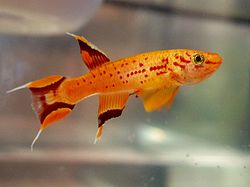| Aphyosemion australe | |
|---|---|
 | |
| Golden variety of Aphyosemion australe Male | |
| Scientific classification | |
| Kingdom: | Animalia |
| Phylum: | Chordata |
| Class: | Actinopterygii |
| Order: | Cyprinodontiformes |
| Family: | Nothobranchiidae |
| Genus: | Aphyosemion |
| Species: | A. australe |
| Binomial name | |
| Aphyosemion australe (Rachow, 1921) | |
| Synonyms [2] | |
Aphyosemion australe, the lyretail panchax, golden panchax or Cape Lopez lyretail, is a species of freshwater fish belonging to the family Aplocheilidae. It is found around Cape Lopez and in surrounding areas in Gabon. [2]
